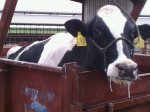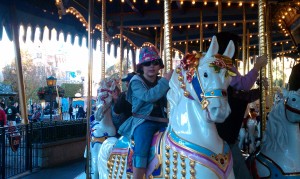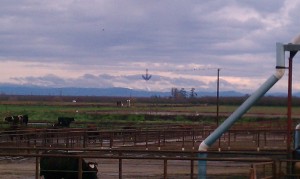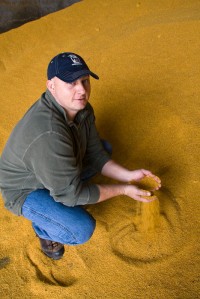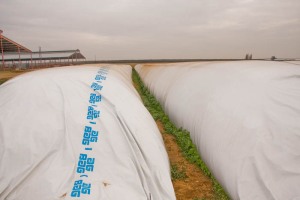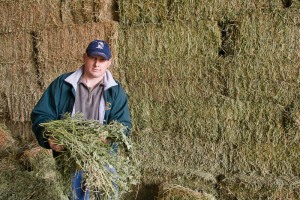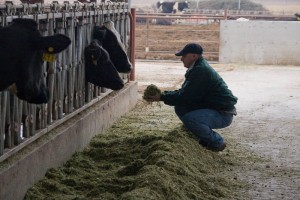Ray-Lin Dairy
Cow
Is my milk safe?
Cleanliness and safety is something that we think about before we even think about milking the cows. Cleanliness starts with the cow beds andalso by keeping our cows healthy . We wash our milk pipelines three times a day once between every milking shift, the milk tank is washed once a day after it has been emptied and the milk pumped out and onto the tanker truck. Food safety is something paid close attention to on a dairy farm here are few pictures showing what we do to produce healthy refreshing milk!

This tank cools the milk and stores it at a chilly 39 degrees. This is a brand new 5000 gallon milk tank we installed a few months ago.

Inside these stainless steel tubes the milk is filtered before ending up in the milk tank. Fresh new filters are installed before each milking shift.
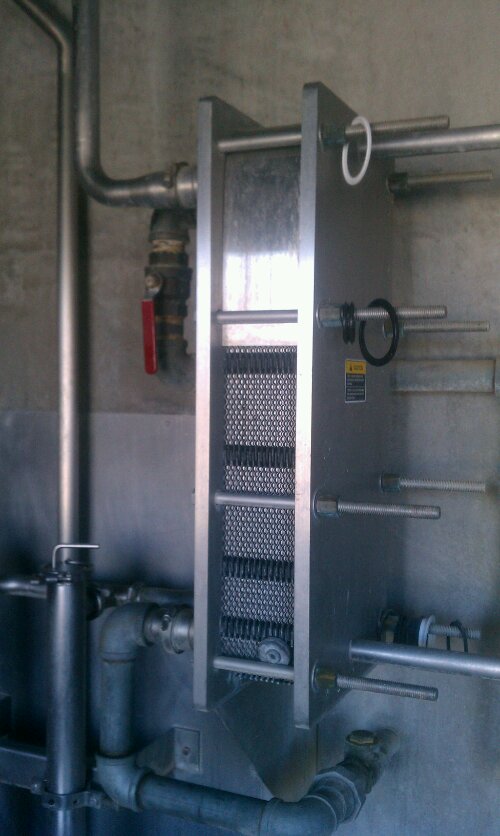
This is a plate cooler that uses water to help cool the milk by nearly 20 degrees before the milk enters the milk tank.

This chart tracks the temperature of the milk and is changed every 48 hours. If you notice the two spikes in temperature they are when the tank is washed daily after the milk is pumped into the milk truck to be taken to the milk plant.

This sink is where the cleaning agents are m ixed with water to wash the pipelines the milk flows through. It is like a big dishwasher for pipes and is used after each milking shift.

the cows teats are dipped with an 1% iodine and lanolin solution to keep them soft and clean.

Although hard to see because it is a clear gold color this is a peroxide based teat sanitizer we use before the cow is milked. It also has lanolin in it to keep the teats soft..

The cleaning agents are automatically added to the wash sink for employee safety.
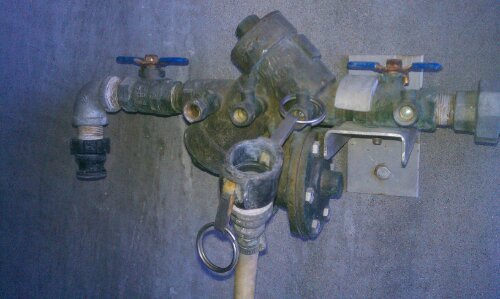
We even take safety as far as protecting our water supply from being contaminated with cleaning agents or milk.

The milking machines are washed in between every milking shift
Cow Bling!

New calves showing off their bling!
On our farm we use eartags to give each animal an unique identifier that allows us to keep important health records for each animal. Here are a few pictures that show the tags up close.

This is used to apply the tags similar to how ears are pierced for earrings
The tags are applied in a similar fashion to earrings through a soft portion of the ear. Each tag is self contained and is clean and sterile.

Each tag has 2 parts this is the male part

Cow bling has a lot of information about the animal
The information of the tags includes our farm brand (starting at the very top of the biggest tag), next is the unique “840” number assigned to only this animal in the United States, followed by the unique number for our farm, in this case 2129. The small white tag has the same numbers and also id an EID tag that contains an RFID information. We currently do not utilize the RFID tag outside of visual use however are we will be implementing the electronic reading in the future to help with efficiency and to eliminate human error.
Lazy Summer Morning
Here is a cow picture for Wordless Wednesday.
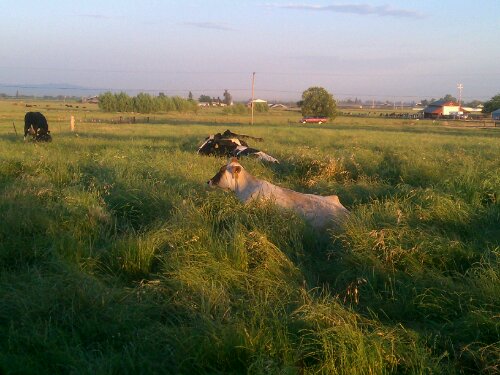
A few of our cows enjoying the cool morning before a hot summer day here in Central California.
These cows were just moved into this pasture yesterday and are relaxing in the grass. With all the late rains we had here in the Central Valley and now the heat the grass is growing very quickly in the pasture. these cows need to get up and get to work eating it down!
Posted from WordPress for Android
Related articles
- Cows play in sprinklers? Wordless Wednesday (raylindairy.wordpress.com)
Making the Cow Beds
Here is a look into what goes into providing the cows on our farm clean soft comfortable beds to lie in. The pictures are from start to finish and show how we take solid manure sterilize and dry it, with a process similar to composting, the finished product is essentially soil we then use for bedding. On our farm we use 95% of the solid manure from the cows as bedding as an effort to recycle all we can and leave a minimal environmental footprint.

With use the cows tend to mess up their beds, we keep trying to get them to make their beds but to no avail.
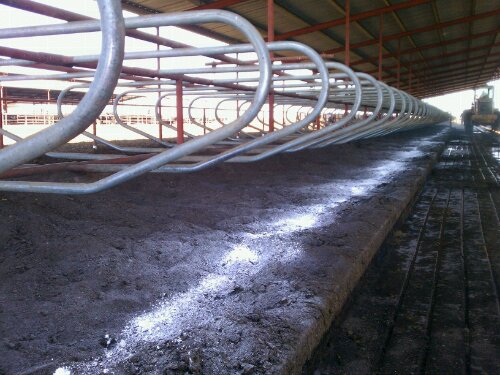
The first thing we do is put down Hydrated Lime to dry out any wet spots, yes cows do occasionally wet the bed.

Next we mix the Lime in with what we call the Freestall Groomer, we use this piece of equipment 3 times a week to re groom the beds.
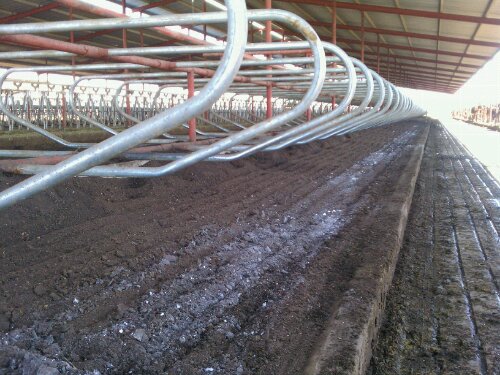
Here is what the beds look like after being groomed.

The next piece of equipment adds more bedding to the stalls.

This is the finished product a clean soft bed for the cows to lie in.

We use a process similar to composting to dry and sterilize the bedding prior to it's use.
Related articles
- Composted manure is the gardener’s best friend (sfgate.com)
- Hints, Tips and Advice on Using Manure in Your Garden (brighthub.com)
Making Cow Food
A few weeks ago we harvested our winter small grain crop to make it into a fermented cow food called silage. Here are a few pictures of the process.

This is what the crop looks like before harvesting.

This machine is a Windrower it cuts the crop and gathers it into rows to be chopped up by another machine

This machine is a Forage Chopper it picks the rows up and cuts it into approximately inch long pieces then blows it into the truck.

the trucks then back into this machine that packs the pieces of the crop into long plastic tubes.

The crop then ferments inside these airtight tubes and within a few weeks it is cow food.
For more about some of the other things we feed our cows read What Do Cows Eat?
Water therapy for cows.

When cows injure themselves we use this tank to help them recover. The water allows the cow to float and stand without having to support her own weight.
I hope Oprah read this!
I wonder if Oprah read this before taking on her Vegan challenge where her and her staff try a vegan diet for a week:
Vegans’ elevated heart risk requires omega-3s and B12, study suggests.
ScienceDaily (2011-02-02) — People who follow a vegan lifestyle — strict vegetarians who try to eat no meat or animal products of any kind — may increase their risk of developing blood clots and atherosclerosis or “hardening of the arteries,” which are conditions that can lead to heart attacks and stroke, study suggests.
I also am hoping Oprah takes up the offer a great friend of mine Mike Haley made by inviting her to his farm in his blog post “Oprah’s one week chalenge”.
Happy 8th Birthday!
Today is a special day in our house according to my dear daughter as she keeps telling me it is because it is her 8th birthday. I tried to convince her it is special because it is the Chinese New Year Day, I must not be very convincing though. There is a special breakfast being made by mom and dad to be eaten on a special plate, then for lunch a surprise will be delivered by her mom and I.
*Our kids nicknames are Big B and Little B some how they both ended up with names that start with B so Brsyon and Brielle quickly came to have these special nicknames.
Dairy farm with a view? – Wordless Wednesday
Our dairy is located to the west of Yosemite National Park in California’s Central Valley and on extremely clear days we get a great view of Half Dome that you can see in this picture.
For a few more pictures of our family farm visit Pinke Post and why she would rather visit our farm than watch Oprah go Vegan for a Week.
What do cows eat?
The cattle on our dairy farm eat diets that are made specifically for them by a ruminant nutritionist. Here on the dairy we mix together individual ingredients to make a ration that is then fed to the cattle. In addition we do have some pasture to supplement the rations.
The ingredients are:
Dried Distillers Grain – this is the grain left from brewing and distilling spirits and is a good source of fat and protein.
Almond Hulls – Outer protective skin when the Almond grows on the tree
Cotton Seed – the inner part of the cotton boll that is left after the cotton fiber is removed
Various silages – made from Corn Plants, and various small grain plants
Alfalfa Hay
Various minerals and vitamins
We also include steamed flaked corn, water and some concentrated energy additives to make the ration.
To learn more about technical information on cattle rations please visit the blog of my great friend Jeff Fowle he is currently doing a series of posts on cattle nutrition.
Related articles
- How does hay help cows digestive system (wiki.answers.com)
- Cows play in sprinklers? Wordless Wednesday (raylindairy.wordpress.com)

